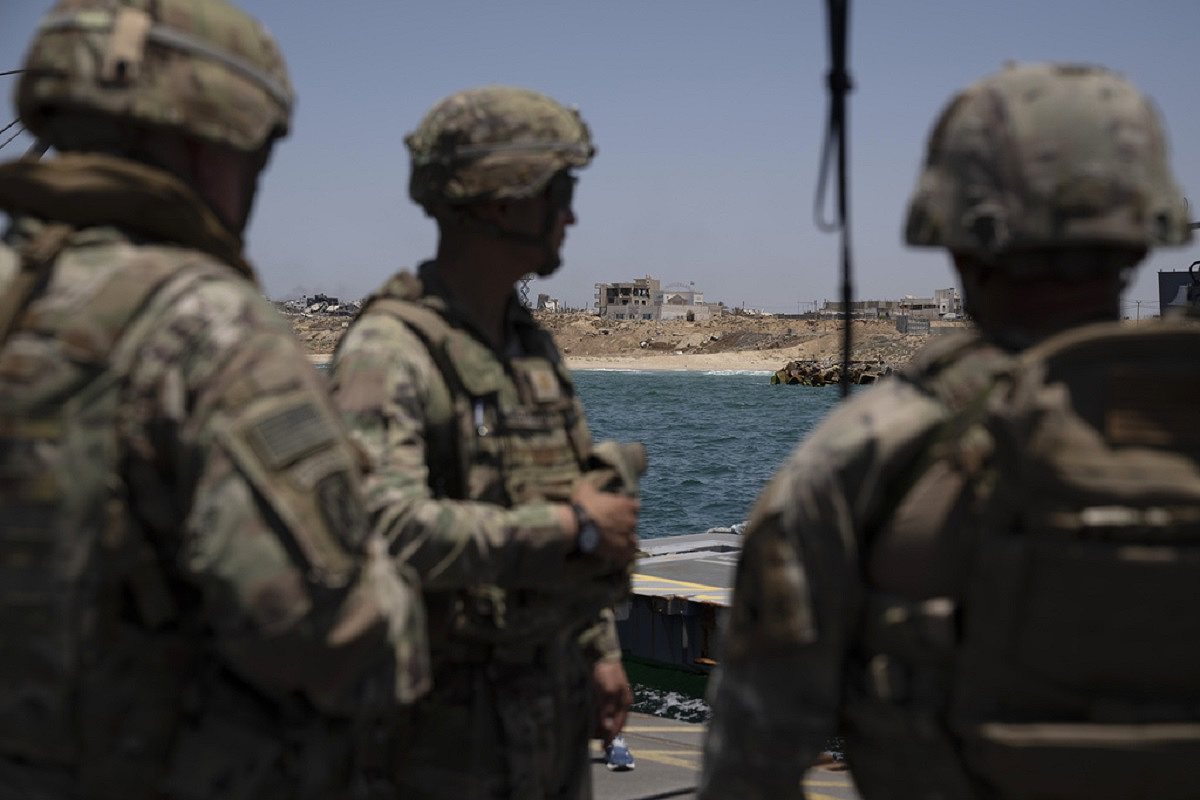
U.S. Army soldiers stand at the U.S.-built floating pier Trident backdropped by the coast of the Gaza Strip, Tuesday, June 25, 2024.
14:49 JST, June 29, 2024
WASHINGTON (AP) — The U.S. military-built pier has been pulled again from the Gaza shore due to rough seas, and its future role in the distribution of aid to Palestinians is uncertain.
Humanitarian aid groups stopped distributing supplies that arrived by sea on June 9 due to security concerns and have not started again. U.S. officials say the pier may not be reinstalled unless aid agencies reach an agreement to begin distributing the aid again. Meanwhile, food and other provisions shipped from Cyprus are piling up on shore, and soon the the secure area on the beach in Gaza will reach capacity.
It’s been a long and difficult road for the pier, which has been battered by weather and troubled by security problems. Here’s a look at how it started and where it is now.
March: announcement and prep
MARCH 7: President Joe Biden announces his plan for the U.S. military to build a pier during his State of the Union address.
“Tonight, I’m directing the U.S. military to lead an emergency mission to establish a temporary pier in the Mediterranean on the coast of Gaza that can receive large shipments carrying food, water, medicine and temporary shelters,” he said.
But even in those first few moments, he noted the pier would increase the amount of humanitarian aid getting into Gaza but that Israel “must do its part” and let more aid in.
MARCH 8: Maj. Gen. Pat Ryder, Pentagon spokesman, tells reporters it will take “up to 60 days” to deploy the forces and build the project.
MARCH 12: Four U.S. Army boats loaded with tons of equipment and steel pier segments leave Joint Base Langley-Eustis in Virginia and head to the Atlantic Ocean for what is expected to be a monthlong voyage to Gaza.
The brigade’s commander, Army Col. Sam Miller, warns that the transit and construction will be heavily dependent on the weather and any high seas they encounter.
LATE MARCH: U.S. Army vessels hit high seas and rough weather as they cross the Atlantic, slowing their pace.
April: construction and hope
APRIL 1: Seven World Central Kitchen aid workers are killed in an Israeli airstrike as they travel in clearly marked vehicles on a delivery mission authorized by Israel.
The strike fuels ongoing worries about security for relief workers and prompts aid agencies to pause delivery of humanitarian assistance in Gaza.
APRIL 19: U.S. officials confirm that the U.N. World Food Program has agreed to help deliver aid brought to Gaza via the maritime route once construction is done.
APRIL 25: Major construction of the port facility on the shore near Gaza City begins to take shape. The onshore site is where aid from the causeway will be delivered and given to aid agencies.
APRIL 30: Satellite photos show the U.S. Navy ship USNS Roy P. Benavidez and Army vessels working on assembling the pier and causeway about 11 kilometers (6.8 miles) from the port on shore.
May: The pier opens … then closes
MAY 9: The U.S. vessel Sagamore is the first ship loaded with aid to leave Cyprus and head toward Gaza and ultimately the pier. An elaborate security and inspection station has been built in Cyprus to screen the aid coming from a number of countries.
MAY 16: Well past the 60-day target time, the construction and assembly of the pier off the Gaza coast and the causeway attached to the shoreline are finished after more than a week of weather and other delays.
MAY 17: The first trucks carrying aid for the Gaza Strip roll down the newly built pier and into the secure area on shore, where they will be unloaded and the cargo distributed to aid agencies for delivery by truck into Gaza.
May 18: Crowds of desperate Palestinians overrun a convoy of aid trucks coming from the pier, stripping the cargo from 11 of the 16 vehicles before they reach a U.N. warehouse for distribution.
May 19-20: The first food from the pier — a limited number of high-nutrition biscuits — reaches people in need in central Gaza, according to the World Food Program.
Aid organizations suspend deliveries from the pier for two days while the U.S. works with Israel to open alternate land routes from the pier and improve security.
MAY 24: So far, a bit more than 1,000 metric tons of aid has been delivered to Gaza via the U.S.-built pier, and USAID later says all of it has been distributed within Gaza.
MAY 25: High winds and heavy seas damage the pier and cause four U.S. Army vessels operating there to become beached, injuring three service members, including one who is in critical condition.
Two vessels went aground in Gaza near the base of the pier and two went aground near Ashkelon in Israel.
MAY 28: Large portions of the causeway were pulled from the beach and moved to an Israeli port for repairs. The base of the causeway remains at the Gaza shore.
June: big crises for the pier
JUNE 7: The damaged causeway was rebuilt and reconnected to the beach in Gaza.
JUNE 8: The U.S. military announced that deliveries resumed off the repaired and reinstalled dock.
The same day, Israel rescued four hostages taken by Hamas during the Oct. 7 attacks in an operation that killed 270 Palestinians.
JUNE 9: World Food Program chief Cindy McCain announced a “pause” in cooperation with the U.S. pier during a TV interview, citing the previous day’s “incident” and the rocketing of two WFP warehouses that injured a staffer.
JUNE 10: WFP said the U.N. would conduct a security review to assess the safety of its staff in handling aid deliveries from the pier. In the meantime, the U.S. military said it would stockpile aid shipments on a secure beach in Gaza.
Ryder, the Pentagon spokesman, said no aspect of the pier or its equipment had been used in Israel’s rescue operation. The Pentagon says an area south of the pier was used for the return of the freed hostages back to Israel.
JUNE 14: The pier was detached from the beach in Gaza to prevent damage during rough seas and allow the military to reattach it more quickly later, U.S. officials said.
JUNE 19: The pier was re-anchored in Gaza and more than 656 metric tons, or 1.4 million pounds, of aid was delivered in the hours after it resumed operations, Ryder said.
Aid agencies, however, did not restart their distribution of the aid, so workers have been storing it in the secure area.
JUNE 28: The pier is removed due to weather, and the U.S. is considering not putting it back unless aid begins heading again to Palestinians in need, several U.S. officials said.
"News Services" POPULAR ARTICLE
-

American Playwright Jeremy O. Harris Arrested in Japan on Alleged Drug Smuggling
-

Japan’s Nikkei Stock Average as JGB Yields, Yen Rise on Rate-Hike Bets
-

Japan’s Nikkei Stock Average Licks Wounds after Selloff Sparked by BOJ Hike Bets (UPDATE 1)
-

Japan’s Nikkei Stock Average Buoyed by Stable Yen; SoftBank’s Slide Caps Gains (UPDATE 1)
-

Japanese Bond Yields Zoom, Stocks Slide as Rate Hike Looms
JN ACCESS RANKING
-

Keidanren Chairman Yoshinobu Tsutsui Visits Kashiwazaki-Kariwa Nuclear Power Plant; Inspects New Emergency Safety System
-

Imports of Rare Earths from China Facing Delays, May Be Caused by Deterioration of Japan-China Relations
-

Tokyo Economic Security Forum to Hold Inaugural Meeting Amid Tense Global Environment
-

University of Tokyo Professor Discusses Japanese Economic Security in Interview Ahead of Forum
-

Japan Pulls out of Vietnam Nuclear Project, Complicating Hanoi’s Power Plans


























